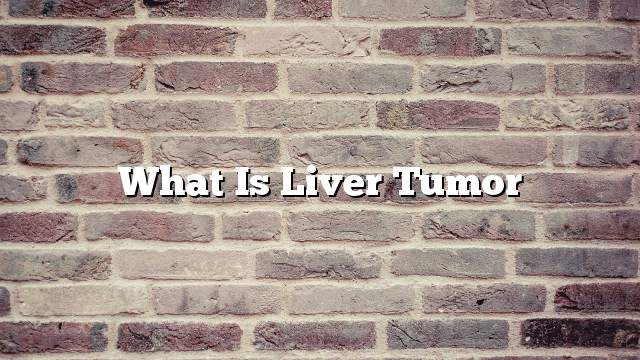Liver
Liver is the largest internal organ in the human body, located in the upper right ventricle of the abdominal cavity. The liver, in its turn as a gland, produces bile, in addition to its important role in purifying blood from harmful substances such as alcohol and drugs. Vitamins, iron and glucose, and converting sugar stored to sugar can be used by the body when low levels of blood sugar, along with the breakdown of hemoglobin, insulin and other body hormones, and works to break red blood cells pyramid, and convert ammonia to urea, Responsible for manufacturing the necessary coagulation factors to stop bleeding in the body.
Liver tumor
Hepatic tumor is an abnormal growth of liver cells and hepatic tumors are different according to the nature of the cells that infect them. Liver tumors divide into primary and secondary.
Primary liver tumors
Primary tumors are tumors that originate from the liver cells, which are:
Secondary or metastatic liver cancer
Secondary or metastasic cancer is caused by the spread of other primary tumors in another organ of the body to the liver, such as gastrointestinal tract tumors.
Factors that increase the risk of liver tumors
The cause of liver cancer is usually unknown, but there are several factors that can increase the risk of liver tumors and cancers, including:
- Hepatitis B virus infection or hepatitis C virus infection.
- Excessive or prolonged intake of alcohol.
- Cirrhosis, a progressive disease of the liver caused by hepatitis B or C, or due to excessive intake of alcohol.
- Diabetes.
- Infection with certain hereditary liver diseases, such as Hemochromatosis and Wilson Disease.
- Nonalcoholic fatty liver disease.
- Exposure to aflatoxins, a toxin produced by growing mold on crops such as peanuts and maize if stored poorly.
Symptoms and signs of liver cancer
Symptoms of liver cancer usually occur in the later stages of the disease, and may include the following:
- Weight Loss Without Reason.
- Anorexia.
- Nausea.
- Vomiting.
- Abdominal pain.
- Swelling or accumulation of fluid in the abdomen.
- Feeling full after eating a little food.
- Fatigue.
- The spleen is enlarged so that the patient feels a lump down the left ribs and may feel a lump down the right ribs as a result of hepatic hypertrophy.
- Color and eye yellowing.
- The color of the stool changes to a whiteish color.
Diagnosis of liver tumors
After knowing the symptoms of the patient, and recording the history of the disease to detect the presence of factors that may be the cause of the person’s liver cancer, the doctor examines the patient clinically and the registration of signs associated with liver cancer, and resort to the work of many laboratory tests and medical images, including:
- Liver Function Tests.
- Blood clotting tests.
- Alpha-Feto-protein testing.
- Tests for the detection of viral hepatitis (Viral hepatitis).
- Kidney function tests.
- Comprehensive blood count (CBC).
- Ultrasound imaging of the liver.
- Computed tomography (CT) for abdominal cavity.
- Magnetic Resonance Imaging (MRI).
- Biopsy by inserting a thin needle in the liver to obtain samples of tissue inside and around the liver to conduct further tests for final diagnosis.
Treatment of liver tumors
The therapeutic plan for the treatment of tumors and liver cancers is based on the stage of the disease, which depends on the size of the tumor and its location and extent of spread, as well as depending on the age of the patient and his general health and preference for treatment on another, and there are several methods followed in the treatment.
Surgical treatment
Surgical treatment includes the following:
- Tumor was removed if the tumor was small and the liver function was good.
- Liver Transplant Surgery: The liver is removed and replaced with a new liver from a donor.
Topical treatment
Topical treatment targets cancer cells or the surrounding area, and topical treatment options include:
- Cryoablation: The cells of the tumor are frozen to kill them. This is done by using the nitrogen fluid injected into the liver cells using the ultrasound to infer the location of the tumor.
- Radiofrequency Ablation: This is done by using an electric current to destroy cancer cells, using ultrasound or CT scan to locate the tumor to direct the current towards it.
- Treatment by injecting the tumor with alcohol, which causes the destruction of cancer cells.
- Use special small balls containing radiation and put them in the liver to deliver radiation directly to the tumor.
- Chemotherapy is injected into the liver (Chemoembolization).
Radiation therapy
A high-energy source such as X-rays or protons is used to destroy cancer cells and reduce tumor size.
Drug-directed treatment
Targeted drug therapy is the drug that interferes with specific tumor abnormalities. These drugs stop or slow the development of cancer tumors for a few months. This method is still needed for further studies to understand the mechanism of taking advantage of certain drugs such as suravenib (in English: Sorafenib) to control liver cancer in its advanced stages.
